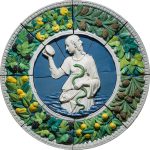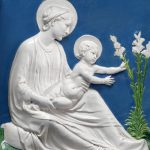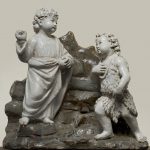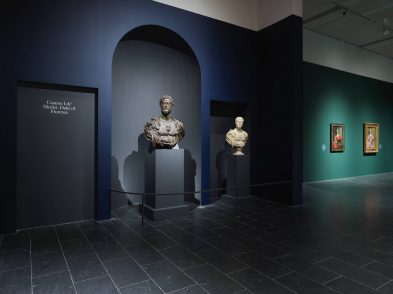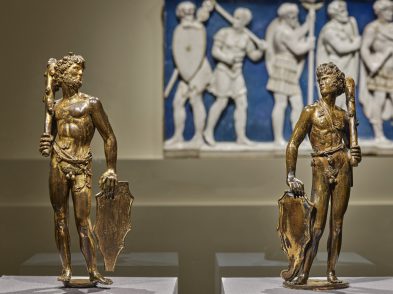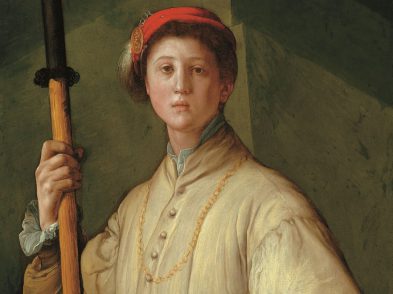“I suppose nothing brings the real air of a Tuscan town so vividly to mind as those pieces of pale blue and white earthenware…like fragments of the milky sky itself, fallen into the cool streets, and breaking into the darkened churches.” –19th century writer William Pater
- Andrea della Robbia, Prudence, c. 1475, glazed terracotta, lent by the Metropolitan Museum of Art, Purchase, Joseph Pulitzer Bequest, 1921
- Luca della Robbia, Madonna and Child, c. 1475, glazed terracotta, National Gallery of Art, Washington, Widener Collection
- Giovanni della Robbia, Christ Child and Young St. John the Baptist, c. 1510, glazed terracotta, Museo Nazionale del Bargello, Florence
If you live stateside and a Tuscan town is not on your travel schedule this spring, consider a trip to Washington, D.C. There’s the world-famous National Cherry Blossom Festival and then there’s Della Robbia: Sculpting with Color in Renaissance Florence on view at the National Gallery of Art, West Building through June 4, 2017. This exhibition and the accompanying catalogue by Marietta Cambareri give a whole new meaning to glazed terracotta (“cooked clay”) and its powers to surprise.
Clay for the Della Robbia artists carried a spiritual message. In the Old Testament, God created Adam from clay. Clay was the oldest medium and it came purely and simply straight from the earth. It was also their earth. Historians believe that the Della Robbias owned property along the Arno river and that they scooped up the sandy clay by the cartloads and hauled it all back to their workshop in Florence’s via Guelfa. Using a medium that is modest and humble carried a double meaning. This humblest of materials was used to create humble figures: chaste Madonnas, sweet-faced babies and weather-worn saints.
Luca della Robbia’s Madonna and Child (c. 1475) embodies this notion. The two figures are made of clay and they are sitting very unceremoniously on the ground, looking quite down to earth. Florentines were very keen on visual puns and this seemingly simple scene would have delighted them. Della Robbia’s renditions of the Madonna and Child were much sought after for devotional images in large part because the terracotta figures were so unassuming and—not irrelevant—relatively cheap.
The tin glazes that the Della Robbias used were also their glazes, top-secret recipes, handed down from generation to generation, although one competitor represented in the exhibition, Santi Buglioni, may have hired a Della Robbia servant girl to pass on the intel. Luca (1399/1400–1482), the patriarch of the family, developed the famous opaque white and striking blue glazes that are synonymous with works by the Della Robbia workshop. The blazing white figures unmistakably evoke purity. The deep rich blue backgrounds suggest a heavenly realm.
Italian Renaissance scholar John Pope Hennessy wrote that Luca instinctively knew the dramatic effect that intense color could convey in large architectural interiors. In the mid 15th century, Florence was certainly specializing in these kinds of spaces. Luca’s first known work using glazed terracotta in a relief sculpture was for the church of Sant’Egidio within the complex of the 13th-century Santa Maria Nuova hospital.
Andrea (1435–1525), his nephew, was drawn to unglazed flesh tones for a more natural look. The third generation freely borrowed from the family’s past while adding an array of new colored glazes. Featured in the show is Andrea’s Virtue of Prudence (c. 1475), a spectacular wall relief that shows new heights in the sculptural and glazing techniques of the Della Robbia workshop. The white glazed figure of Prudence represents the wisdom of looking ahead. Here she is shown with her attributes, a mirror and a snake, and curiously a bald head that morphs into the back of the face of an elderly man. Andrea’s distinctive style is visible: Prudence’s realistically draped dress is far more elaborate than any rendition of clothing Luca depicted.
Even more dramatic though is Andrea’s luxuriant frame of pine cones, fruits—including the offbeat addition of cucumbers—all with their botanically accurate leaf representations. There is some evidence that Andrea used actual fruits and pine cones to mold these sculptures. Your eye roams around the frame as if you were literally walking through a garden, ready to pluck off one of those succulent looking quinces.
The garland around Prudence brought one surprise to the curators and art handlers of this exhibition. The frame had been sculpted and fired in pieces, which were labeled according to the order that Andrea wanted. The Metropolitan Museum of Art lent the work to the exhibition and as the art handlers were dismantling the pieces for shipment, they noticed a very old labeling system. The frame had been displayed in the wrong order—for how many years we do not know. The catalogue had already been published with a photo inside and on the back cover showing the incorrect order. The error was easily corrected for the show, however, and the photograph included here is exactly what was originally intended by Andrea.
The five rooms of this show are pure pleasure for lovers of Florentine art and the experience is all the more special since it allows visitors to roam into neighboring rooms, taking in what is considered the most exceptional collection of Renaissance works of art in the country.
Della Robbia: Sculpting with Color in Renaissance Florence
West Building, Main Floor – West Garden Court, National Gallery of Art, Washington, D.C.
Until June 4, 2017

